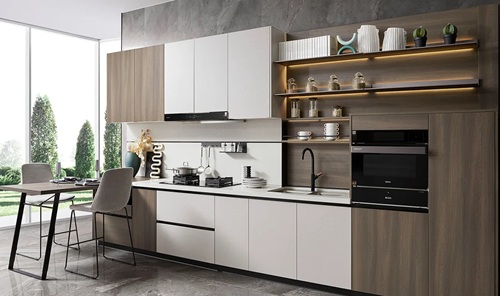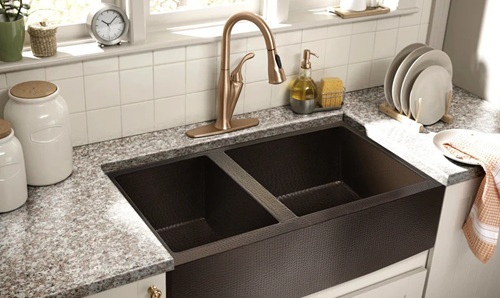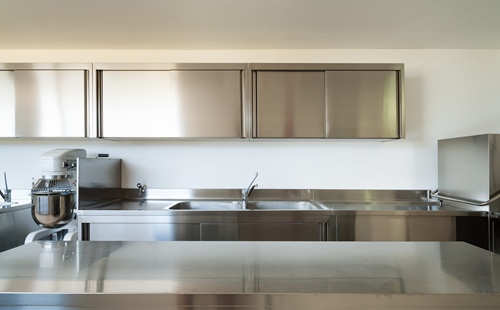In today’s modern kitchens, veneer kitchen cabinets have become a popular design choice for homeowners and interior designers looking for a sleek, contemporary aesthetic. Veneer cabinets offer the beauty of real wood while providing some cost and performance benefits over traditional solid wood cabinetry. But are they the right fit for your kitchen?
This article provides a comprehensive look at the pros and cons of veneer kitchen cabinets—highlighting everything from durability and maintenance to aesthetics and price.

What Are Veneer Kitchen Cabinets?
Veneer kitchen cabinets are made using thin slices of real wood, typically 0.5 to 2 mm thick, which are glued onto a core material like plywood, MDF (medium-density fiberboard), or particle board. This construction allows for the appearance of solid wood at a reduced cost and weight.
There are several types of veneers used in kitchens:
- Natural Wood Veneer – Made from real wood species like oak, teak, or walnut.
- Reconstituted Veneer – Engineered to look like wood, made from fast-growing trees and dyed/compressed for uniformity.
- Laminate Veneer – Often called “wood-look laminate,” made from printed paper layers and melamine resin (not real wood).
This article focuses on natural wood veneers, which combine aesthetics and eco-conscious manufacturing.
✅ Pros of Veneer Kitchen Cabinets
1. Aesthetic Appeal of Real Wood
One of the main advantages of veneer cabinets is that they look just like solid wood. Because veneers are made from real wood slices, you get natural grain patterns, rich color tones, and a warm organic look.
Design Tip: Veneer is ideal for achieving high-end, minimalist, or Scandinavian-style kitchens with smooth, sleek finishes.
2. More Affordable Than Solid Wood
Veneer cabinets are significantly less expensive than their solid wood counterparts. Since the wood layer is thin and applied over economical core materials like MDF, they offer cost savings without compromising appearance.
Fact Check:
- Solid wood kitchen cabinets can cost ₹2,500–₹5,000 per sq. ft.
- Veneer kitchen cabinets typically cost ₹1,500–₹3,500 per sq. ft., depending on the wood type and finish.
3. Environmentally Friendly
Veneers make efficient use of valuable wood species by using only a thin slice rather than an entire board. This results in less deforestation and reduced waste, especially when paired with sustainable core materials like plywood or recycled MDF.
4. Dimensionally Stable
Because veneers are bonded to a stable substrate like plywood or MDF, they are less likely to warp, expand, or contract due to humidity or temperature changes—common problems with solid wood cabinets.
This makes veneer cabinets ideal for humid climates or kitchens that see lots of temperature fluctuations.
5. Flexible Finishing Options
Veneer surfaces can be:
- Stained or polished to highlight wood grain
- Matte, semi-gloss, or glossy
- Varnished or laminated for added protection
With careful selection, you can customize the look to match both modern and traditional kitchens.
❌ Cons of Veneer Kitchen Cabinets
1. Prone to Peeling or Chipping
Over time, and especially in high-use areas like near the sink or cooktop, veneer layers can peel, chip, or bubble—particularly if exposed to moisture or if not well-sealed.
Tip: Always choose high-quality veneer bonded with strong adhesives and finished with a protective topcoat.
2. Less Durable Than Solid Wood
While more dimensionally stable, veneer cabinets are more susceptible to surface damage than solid wood. Scratches, gouges, or water damage can penetrate the thin veneer layer, making repairs more difficult.
Warning: Deep scratches may reveal the underlying MDF or particle board, ruining the visual appeal.
3. Limited Refinishing Potential
Unlike solid wood, which can be sanded and refinished multiple times, veneer has limited thickness, making refinishing a challenge. In most cases, only light sanding or touch-ups are possible.
Fact: Attempting to sand down veneer surfaces aggressively can wear through the wood layer and expose the substrate.
4. Quality Varies Widely
There’s a broad spectrum in the quality of veneer cabinets. Low-end versions may use poorly bonded or thin veneers that peel easily. It’s essential to ensure your cabinets are made with strong adhesives, quality substrates, and proper sealing.
5. Susceptible to Water Damage
If water seeps through the edges or seams, especially in kitchens where spills are common, it can damage the core material, causing it to swell or delaminate. Unlike solid wood, which resists water to some extent, MDF and particle board absorb moisture quickly.
⚖️ Veneer vs. Other Cabinet Materials
| Feature | Veneer | Solid Wood | Laminate | Acrylic | PVC/Modular |
| Aesthetic Appeal | High (real wood look) | Very High (authentic) | Moderate–High (printed) | High-gloss modern | Moderate |
| Cost | Moderate | High | Low–Moderate | Moderate–High | Low |
| Durability | Moderate | High | Moderate | High | Moderate |
| Water Resistance | Low–Moderate | Moderate | High | High | High |
| Refinishing Ability | Low | High | None | None | None |
| Eco-Friendliness | High | Moderate | Low | Low | Low |
| Maintenance | Moderate | High | Low | Low | Low |
🛠️ Maintenance Tips for Veneer Cabinets
- Wipe Spills Immediately – Don’t let water sit on the surface or seep into seams.
- Use Soft Cloths – Avoid abrasive scrubbers that may scratch the veneer.
- Apply Wood Polish Occasionally – Helps maintain luster and adds a layer of protection.
- Avoid Harsh Chemicals – Use pH-neutral cleaners to preserve the finish.
- Seal Edges – Especially near sinks, dishwashers, and cooktops to prevent peeling.
🏁 Should You Choose Veneer Kitchen Cabinets?
✅ Veneer Cabinets Are a Great Choice If:
- You love the look of real wood but want a more affordable option.
- You prefer modern, sleek finishes in natural tones.
- You want eco-friendly cabinetry with reduced environmental impact.
- You live in a humid climate and need dimensionally stable materials.
- You’re okay with light maintenance and occasional touch-ups.
❌ You May Want to Avoid Veneer Cabinets If:
- You need maximum durability and frequent refinishing options.
- Your kitchen sees heavy water exposure or rough use.
- You’re not willing to invest in high-quality veneer products (low-quality versions fail faster).
🧾 Final Verdict
Veneer kitchen cabinets strike an excellent balance between aesthetic appeal, sustainability, and cost-efficiency. With real wood looks and modern construction methods, they offer a premium feel without the premium price. However, they require careful handling, proper sealing, and periodic maintenance to preserve their beauty and functionality.
For homeowners looking to combine style and practicality, veneer cabinets are a strong contender—especially when paired with quality craftsmanship and thoughtful kitchen design.

